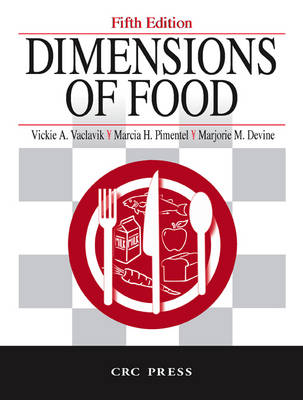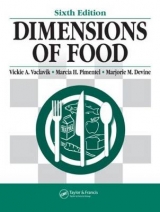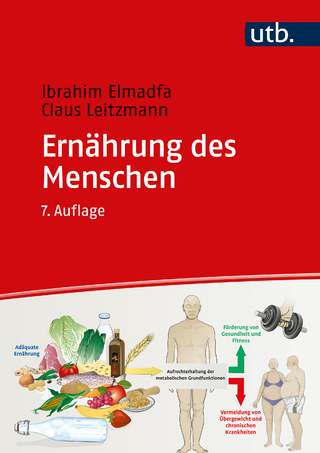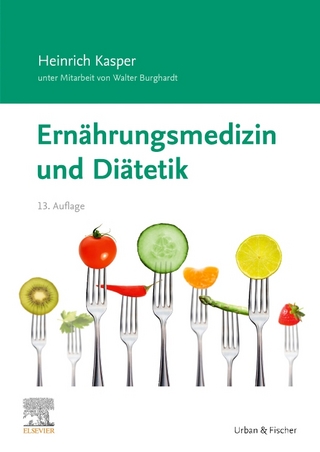
Dimensions of Food, Fifth Edition
Crc Press Inc (Verlag)
978-0-8493-1425-4 (ISBN)
- Titel erscheint in neuer Auflage
- Artikel merken
A popular workbook, Dimensions of Food has been imparting knowledge of foods to students of nutrition and dietetics, food science, and other food-related fields for three decades. Updated to reflect the latest trends and regulations, the fifth edition includes current information regarding nutrition, food legislation and mandated food labeling, and it presents more background information than in previous editions. The manual provides a variety of stimulating exercises and laboratory discussions through which students can explore and better understand the multidimensional nature of food decisions and preparation.
Dimensions of Food, Fifth Edition presents sequenced learning experiences that move from basic demonstrations of key principles in earlier chapters, to their applications in later chapters. For example, students will explore food economics, labeling, and the assessment of nutrient quality of diets based on the Food Guide Pyramid, then they will observe demonstrations and experiments that provide the basics to understanding the functional and structural properties of the components of foods. Questions and problems throughout the manual facilitate application of principles to many food situations. Once completed, the book serves as an essential reference guide for personal and professional use. For success in using this workbook, it is good to know that a previous knowledge of food preparation is not mandatory for success!
The workbook is designed to help students clarify and organize facts into working principles. Activities may be carried out in the laboratory, demonstrated, or assigned as projects to be completed outside of the classroom, such as at home in the kitchen, or in the grocery store. With Dimensions of Food, Fifth Edition, students will gain a comprehensive understanding of the science of food involved in food preparation, the nutritional contents of food, and the effects of processing on nutritional value. They will observe the important connections between good taste and food selection, between diet and optimum health. They will recognize that nutrition, food safety, and the economics of the marketplace are all important factors when making food decisions.
Vaclavik; Vickie A. University of Texas Southwestern Medical Center, Texas, USA,Pimentel; Marcia H. Cornell University (Retired), New York, USA,Devine; Marjorie M. Cornell University (Retired), New York, USA,
Preface
References
World Wide Web (WWW) Sites
PART I.DIMENSIONS OF FOOD
Economic Dimensions
Exercise 1: Factors Influencing Cost of Food
Exercise 2: Labels as Guides in Food Purchasing
Summary Questions-Economic Dimensions
Nutritional Dimensions
Exercise 1: Determining Serving Size
Exercise 2: Factors Affecting Caloric Value of Foods
Exercise 3: Nutrient Contributions of the Food Guide Pyramid
Exercise 4: Evaluation of a Daily Menu
Exercise 5: Labels as Guides to Nutrient Content
Summary Questions-Nutritional Dimensions
Palatability Dimensions
Exercise 1: Identifying Sensory Properties of Food
Exercise 2: Evaluating Sensory Properties in Foods
Exercise 3: Sensory Evaluation Tests
Exercise 4: Evaluating Personal Preferences
Summary Questions-Palatability Dimensions
Chemical Dimensions
Exercise 1: Functions of Food Additives
Exercise 2: Relationship of Additive Use to Degree of Processing
Exercise 3: Evaluation of Snack Foods
Exercise 4: Sodium Content of Foods
Summary Questions-Chemical Dimensions
Sanitary Dimensions
Exercise 1: Factors Affecting the Microbial Safety of Foods
Exercise 2: Temperature Control in Food Handling
Exercise 3: Sanitization in the Food Preparation Environment
Summary Questions-Sanitary Dimensions
Food Processing Dimensions
Exercise 1: Processing Temperatures
Exercise 2: Food Processing, Canning
Questions-Canning
Exercise 3: Food Processing, Freezing
Questions-Freezing
Summary Questions-Dimensions of Food
PART II. FOOD PRINCIPLES
Measurements, Use of Ingredients, and Laboratory Techniques
Exercise 1: Demonstration of Measuring and Mixing Techniques
Exercise 2: Measuring Liquids
Exercise 3: Measuring Solids
Exercise 4: Clean-up
Summary Questions-Measurements, Use of Ingredients, and Laboratory Techniques
Cereal and Starch
Exercise 1: Separation of Starch Granules
Exercise 2: Properties of Wheat and Cornstarch
Exercise 3: Effect of Sugar and Acid on Gelatinization
Exercise 4: Application of Principles to Starch-Thickened Products
Exercise 5: Preparing Cereal Products
Evaluation of Cereal Products
Cereal Recipes
Evaluation - Cereal Recipes
Summary Questions-Cereal and Starch
Fruits and Vegetables
Exercise 1: Properties of Parenchyma Cells
Exercise 2: Assessing Nutrient Loss in Fruits and Vegetables
Exercise 3: Fruits
Exercise 4: Cooking Vegetables
Evaluation of Vegetable Recipes
Nutritive Value of Assigned Recipes
Vegetable Recipes
Recipe Questions
Summary Questions-Fruits and Vegetables
Meat, Poultry, and Fish
Exercise 1: Identification of Basic Meat Cuts
Exercise 2: Effect of Dry and Moist Heat on Less Tender (Tough) Cuts of Meat
Exercise 3: Evaluation of Meat, Poultry, and Fish
Meat, Poultry, and Fish Recipes
Summary Questions-Meat, Poultry, and Fish
Plant Proteins
Exercise 1: Pretreatment and Cooking for Legumes/Lentils
Exercise 2: Combining Plant Proteins
Evaluation of Plant Protein Recipes
Plant Protein Recipes
Summary Questions-Plant Proteins
Eggs And Egg Products
Exercise 1: Egg Quality
Exercise 2: Coagulation of Egg Protein in Baked and Stirred
Exercise 3: Egg White Foams
Exercise 4: Effect of Added Substances on Egg White Foam
Exercise 5: Effect of Cooking Intensity on Egg Protein
Evaluation of Eggs Cooked In Various Ways
Exercise 6: Characteristics of Cooked Modified Egg Mixtures
Exercise 7: Combining Starch and Eggs as Thickeners in One Product - Soufflé
Soufflé Recipes
Summary Questions-Eggs and Egg Products
Milk and Milk Products
Exercise 1: Comparison of Milk and Non-Dairy Products
Exercise 2: Coagulation of Milk Protein
Exercise 3: Combining Acid Foods with Milk
Exercise 4: Comparison of Cheese Products
Exercise 5: Effect of Heat on Natural and Processed Cheese
Summary Questions-Milk and Milk Products
Fats and Oils
Exercise 1: Separation and Ratio of Oil and Acid; Emulsifiers
Exercise 2: Application of Principles to Salad Dressings
Salad Dressing Recipes
Exercise 3: Fat-Free, Fat-Reduced, and Fat Replaced Products
Exercise 4: Comparison of Dietary Fats
Summary Questions-Fats and Oils
Sugars, Sweeteners
Exercise 1: Methods of Initiating Crystallization
Exercise 2: The Relationship of Sugar Concentration to Boiling Point
Exercise 3: Effect of Temperature and Agitation on Crystal Size
Exercise 4: Effect of Interfering Agents on Sugar Structure
Candy Recipes
Exercise 5: Sugar Substitutes, High-Intensity Sweeteners
Summary Questions-Sugars, Sweeteners
Batters and Doughs
Exercise 1: Measurement of Flour
Exercise 2: Structural Properties of Wheat Flour
Questions-Gluten
Exercise 3: Chemical Leavening Agents
Exercise 4: Factors Affecting the Leavening Power of Yeast
Questions-Leavening Agents
Exercise 5: Drop Batter, Muffins
Questions-Muffins
Exercise 6: Soft Dough, Biscuits
Questions-Biscuits
Exercise 7: Pancakes, Popovers, Cream Puffs
Questions-Pancakes, Popovers, and Cream Puffs
Exercise 8: Stiff Dough -Yeast Breads/Rolls
Evaluation of Yeast Rolls
Questions-Yeast Breads/Rolls
Exercise 9: Shortened Cakes
Evaluation of Cakes
Questions-Cakes
Exercise 10: Stiff Dough - Pastry
Evaluation of Pastry
Palatability of Pies
Questions-Pastry
Summary Questions-Batters and Doughs
PART III. HEATING FOODS BY MICROWAVE
Microwave Cooking
Exercise 1: Effect of Cooking Procedure on Pigments and Flavors
Exercise 2: Fruits
Exercise 3: Vegetables
Exercise 4: Starch Products
Exercise 5: Eggs
Exercise 6: Meat, Poultry, and Fish
Exercise 7: Batters and Doughs
Exercise 8: Reheating Baked Products
Exercise 9: Defrosting
Summary Questions-Microwave Cooking
PART IV. MEAL MANAGEMENT
Meal Management
Exercise 1: Analyzing Menus for Palatability Qualities
Exercise 2: Economic Considerations in Menu Planning
Exercise 3: Low Calorie Modifications
Exercise 4: Meal Planning
Exercise 5: Meal Preparation
Student Evaluation
Summary Questions-Meal Management
APPENDICES
Legislation Governing the Food Supply
Food Guides and Dietary Guidelines
Some Food Equivalents
Average Serving or Portion of Foods
Food Additives
pH of Some Common Foods
Major Bacterial Foodborne Illnesses
Meat and Egg Cooking Regulations
Heat Transfer
Symbols for Measurements and Weights
Notes on Test for Presence of Ascorbic Acid
Cooking Terms
Buying Guide
Spice and Herb Chart
Plant Proteins
| Erscheint lt. Verlag | 7.6.2002 |
|---|---|
| Zusatzinfo | 79 Illustrations, black and white |
| Verlagsort | Bosa Roca |
| Sprache | englisch |
| Maße | 216 x 279 mm |
| Gewicht | 744 g |
| Themenwelt | Sachbuch/Ratgeber ► Essen / Trinken |
| Sachbuch/Ratgeber ► Gesundheit / Leben / Psychologie | |
| Medizin / Pharmazie ► Gesundheitsfachberufe ► Diätassistenz / Ernährungsberatung | |
| Naturwissenschaften | |
| Technik ► Lebensmitteltechnologie | |
| ISBN-10 | 0-8493-1425-9 / 0849314259 |
| ISBN-13 | 978-0-8493-1425-4 / 9780849314254 |
| Zustand | Neuware |
| Haben Sie eine Frage zum Produkt? |
aus dem Bereich



